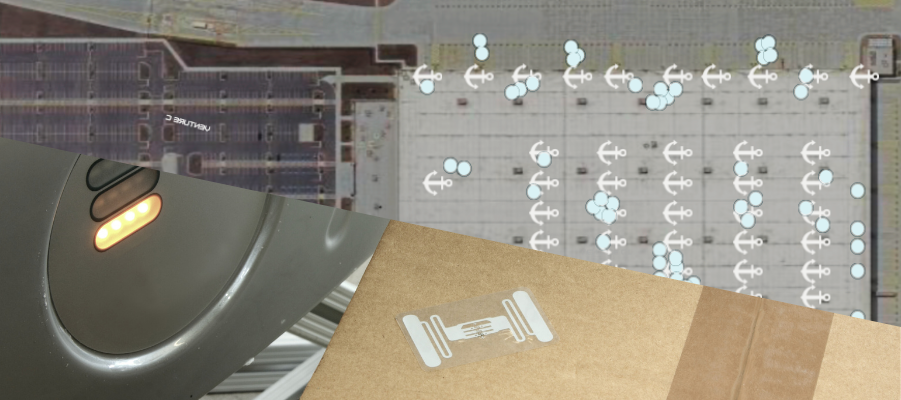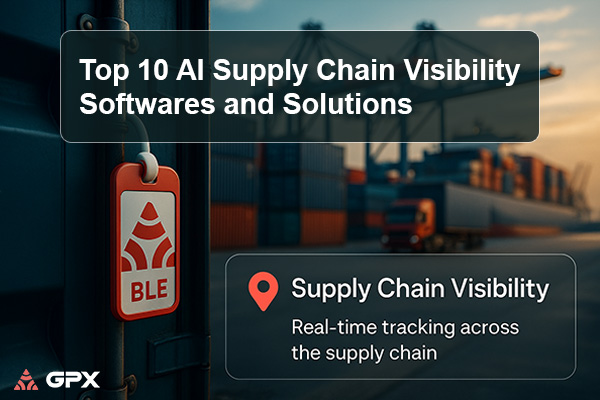Ditching Fragmented RFID Data for Mesh-Networked GPS + BLE Tech

Creating Truly Unified & Actionable Insights
In most business operations, supply chain, and logistics, the efficiency and accuracy of asset tracking are paramount. Prominent technologies employed for managing assets in a warehouse, in the field, or in transit are Radio Frequency Identification (RFID) and, more recently, Global Positioning System (GPS) combined with Bluetooth Low Energy (BLE) in a mesh-networked environment.
We will delve into the intricacies of these technologies, comparing their infrastructure requirements, operational mechanisms, and overall effectiveness. We will clarify why a mesh-networked GPS + BLE system emerges as the superior choice for modern warehouse and supply chain visibility.
Understanding RFID Technology
What is RFID?
RFID (Radio Frequency Identification) is a technology that uses electromagnetic fields to automatically identify and track tags attached to objects. An RFID system consists of three main components: an RFID tag or transponder, an RFID reader or transceiver, and an antenna. The tags, which contain electronically stored information, can be passive or active. Passive tags draw power from the RFID reader’s interrogating signal, whereas active tags have their own power source which lets them emit their unique identifier.
How RFID Works
When an RFID tag comes within range of an RFID reader, the reader reads the signal transmitted by the tag. The reader then passes along that RFID tag’s unique identifier to a computer server, identifying that tag’s location and the reader it was read by, allowing it to be used for tracking purposes.
RFID in Warehouse and Supply Chain Management
In warehouse and supply chain management, RFID is used to track inventory, manage stock levels, and streamline logistics operations. RFID tags are attached to pallets, containers, and individual items, allowing for real-time visibility of goods as they move through the supply chain.
Advantages and Limitations of RFID
Advantages
- Tag Cost: RFID tags are cheap and can easily be printed on labels allowing for tracking of goods at scale.
- Automation: RFID systems can be read by automated inventory tracking systems or handheld readers, reducing the need for manual data entry, as long as they’re within range of the reader.
- Durability: RFID tags are generally durable and can withstand harsh environments.
Limitations
- Infrastructure Requirements: RFID systems require significant infrastructure investment, including readers, antennas, and gateways, to be installed at key points like receiving bays, exit points, or throughout a warehouse.
- Tag Location is Inaccurate When Not in Presence of Scanner: Once an RFID tag has been ‘scanned out’ of a warehouse or other location where scanning infrastructure is setup, it can be difficult to track down that asset. High cost and unwillingness of suppliers or during shipment limits location accuracy until RFID tag is scanned again.
- Manual Intervention: Despite automation, RFID often still requires manual scans at various stages, introducing potential for human error.
- Range and Interference: Passive RFID tags have a limited range, and signals can be affected by metal objects and liquids.
Continued Supply Chain Visibility Issues With RFID
While RFID offers benefits, some companies implementing it still struggle with complete supply chain visibility.
Chipotle
A 2023 article by Supply Chain Dive highlights Chipotle’s experience. While RFID improved their visibility, achieving end-to-end visibility required supplier integration [1]. This demonstrates that fragmented data across different parties in the supply chain remains a challenge. Additionally, RFID can be susceptible to interference in metal-heavy environments or when tags are damaged or improperly placed [1]. This highlights the need for a robust tracking system that can overcome these limitations.
Texas Health Resources
Texas Health Resources (THR), a large healthcare system, implemented RFID tracking for medical equipment in 2014. While it improved some aspects of inventory management, they encountered limitations in achieving complete visibility [2]. A 2017 article by Healthcare IT News highlights the challenges they faced:
- Read Range Obstructions: Metal equipment cabinets and walls in hospitals often blocked RFID signal penetration, hindering real-time location tracking [2].
- Limited Data Insights: RFID tags primarily provided location data, lacking additional information like equipment status (available, in use, requiring maintenance) [2].
Walmart
“Going for (Not So) Broke: The True Cost of RFID” discusses the real costs of RFID implementation, highlighting that initial predictions were exaggerated. Costs can range from $15,000 to $400,000 depending on the scope. The primary expenses are consulting, integration, and hardware. Specifically, Walmart’s challenges included poor read rates, unclear responsibilities, and resistance from suppliers. Despite initial high costs and limited success, ongoing expenses focus on tags and system upgrades, with cautious, phased implementations.
Here at GPX, we pose this question: If a company with pockets as deep as Walmart’s struggles to find ROI on RFID implementations across the supply chain, how likely is the average retailer, manufacturer, or other segment leader supposed to navigate ROI? This illustrates how RFID is oversold as the ‘silver bullet’ to so many industries, but in reality, only solves a fraction of one part of visibility and management of the supply chain.
Construction Industry Adoption
And in one final example, we turn to the construction industry: RFID has been adopted by several companies in the construction sector to manage materials and track equipment. However, challenges remain. Construction companies often deal with large quantities of materials and complex supply chains, which require extensive RFID infrastructure and integration [4]. Thus, RFID solutions can easily become overwhelmed by the complexity of these use-cases.
Bloor Research also highlights the complexity of managing the data coming from these devices: “Implementing RFID is a major commitment for an organization, and when a return on the investment may be years away, it is essential that the technology chosen functions reliably and is resilient. Planning, piloting and implementing your RFID system in isolation is one problem, but ensuring it integrates smoothly with your other IT systems and those of your partner organizations is a whole new can of worms. RFID systems throw out huge amounts of data, and where organizations are working in partnership with others, for example in a supply chain, there are immense challenges of data synchronization, standardization, general management and overall ownership.”
The reliance on extensive infrastructure and the need for human intervention at various checkpoints continue to hinder the effectiveness of RFID, underscoring the necessity for more advanced and automated solutions like mesh-networked GPS + BLE for comprehensive visibility.
Introduction to GPS + BLE Mesh Networks
What is GPS?
The Global Positioning System (GPS) is a satellite-based navigation system that provides location and time information in all weather conditions, anywhere on or near the Earth. It consists of a constellation of satellites orbiting the Earth, ground control stations, and GPS receivers.
What is BLE?
Bluetooth Low Energy (BLE) is a wireless communication technology designed for short-range communication with low power consumption. BLE is widely used in various applications, including health monitoring devices, smart home systems, and location tracking.
How GPS + BLE Mesh Networks Work
In a mesh-networked GPS + BLE system offered by GPX Intelligence, we merge the flexibility of GPS tracking and the low-cost and size advantage of BLE tags to increase tracking coverage in and outside of customer owned facilities.
The GPS Tracker can track its location based on GPS, WiFi, or Cell tower location and when it gets a location, along with reading BLE tags in its vicinity, provide the location of those BLE tags. This enables cost-effective tracking of a wider range of assets that should move together. While BLE tags cannot connect and share their location with the GPX Intelligence platform, in the event that a BLE tag is not read by a GPS + BLE tracker, its location will persist, showing its last known location for further investigation.
The GPS Tracker + BLE Tag is meant to provide widespread coverage of goods on the go. Setting up either tracker or BLE tag as an anchor inside a specific facility can increase the location accuracy in large warehouse or factory environments.
Advantages of Mesh-networked GPS + BLE
- Comprehensive Coverage: A mesh-networked GPS + BLE system offers comprehensive coverage, ensuring continuous tracking of assets regardless of their location. GPS provides accurate outdoor tracking, while BLE beacons cover indoor environments, including warehouses and manufacturing facilities.
- Minimal Infrastructure: Unlike RFID, a GPS + BLE system requires minimal infrastructure. BLE beacons can be easily installed without the need for extensive wiring or gateways. This reduces setup costs and simplifies maintenance.
- Automation and Accuracy: GPS + BLE systems automate the tracking process, eliminating the need for manual scans and reducing the risk of human error. The mesh network allows for real-time data collection and transmission, providing accurate and up-to-date information on asset location and status.
Comparing RFID with Mesh-networked GPS + BLE
Infrastructure Requirements
One of the most significant differences between RFID and GPS + BLE systems is the infrastructure required. RFID systems necessitate the installation of readers, antennas, and gateways at various points throughout a facility. This can be costly and time-consuming, and it requires ongoing maintenance. Often, suppliers or third parties involved in the tracking of goods marked with RFID labels will not make the same investments, causing a loss of visibility outside the owned facilities.
In contrast, a GPS + BLE system requires minimal infrastructure. If you want to increase accuracy inside a specific facility, to know if it’s located on a loading dock or storage area for example, you can add additional BLE tags and anchor them in the facility. Otherwise, the GPS trackers and BLE tags will be read both inside and outside the facility as they move together through shipper locations, from suppliers or on to distributors.
Operational Efficiency
RFID systems still inherently rely on manual scans at various stages of the supply chain. Workers must scan RFID tags as items move through different checkpoints. The manual intervention not only introduces the possibility of human error but often results in inconsistent scanning practices. Perhaps it’s due to high workloads, or maybe employees accidentally skip scans – tracking data quality suffers, and therefore location visibility becomes less clear. Additionally, passive RFID tags have a limited read range, meaning items must be brought close to readers for their information to be captured.
Anecdotal evidence from a variety of leads and customers highlights a more glaring inefficiency: companies often invest heavily in RFID infrastructure, including the cost of readers, gateway readers, installation, and training. However, these investments frequently fall short of expectations. Company employees or suppliers may regularly neglect proper scanning protocols, scan incorrectly, or receive product in a bay without a gateway reader, rendering the entire RFID system ineffective. This failure to consistently scan RFID tags can make the data collected incomplete or unreliable, leading to significant visibility gaps in the supply chain. Consequently, the anticipated benefits of RFID are not realized, and the substantial costs associated with its implementation become a sunk investment.
On the other hand, GPS + BLE systems automate the tracking process with minimal human intervention and reduces the risk of errors. The mesh network enables real-time data collection and transmission, ensuring that asset location and status information is accurate and up-to-date.
Cost and Scalability
The cost of implementing and maintaining an RFID system can be high due to the required infrastructure and the need for manual scans. Additionally, scaling an RFID system to cover larger areas or more complex supply chains can be challenging and costly.
In contrast, a GPS + BLE system is more cost-effective and scalable. BLE beacons are inexpensive and easy to install, and the mesh network can be expanded simply by adding more beacons, along with GPS devices. This makes GPS + BLE an ideal solution for large warehouses, distribution centers, and complex supply chains.
GPS + BLE Use Cases and Applications
The versatility and efficiency of GPS + BLE systems make them suitable for a wide range of applications:
Warehouse Management
Mesh-networked GPS + BLE can track the location of forklifts, pallets, and individual inventory items in real-time. GPX offers the unique capability of configuring “anchors” to improve interior warehouse tracking. This increases inventory accuracy, optimizes warehouse operations, and reduces the risk of lost or misplaced items.

Supply Chain Management & Manufacturing
GPS + BLE mesh-networked technologies provide end-to-end visibility of goods as they move through the supply chain, regardless of whether they’re inside a facility or on the road. This enables companies to monitor the location and status of shipments in real-time, improving delivery times and reducing the risk of theft or damage.

Agricultural Product Quality
In agriculture, freshness is paramount. Mesh-networked BLE + GPS empowers farmers to significantly reduce cut-to-cool times, ensuring peak quality produce reaches consumers. BLE tags on nut, fruit, and vegetable crates or trailers can track their location throughout the harvesting, transportation, and storage process. Adding a temperature sensors with the GPS + BLE provides real-time insights, allowing farmers to optimize time spent in the field before reaching cool storage. This level of insight helps prevent spoilage and translates to increased profitability and reduced food waste.
Agriculture & Construction Equipment Management
For farms and construction sites, mesh-networked BLE + GPS goes beyond simple tracking. Imagine a scenario where a tractor breaks down in a remote field. With a GPS device attached that, critically, is not reliant upon the machine being turned on, you can pinpoint its exact location at any time, allowing for faster dispatch of implements, support equipment, or repair crews. Similarly, on a construction site, managers can identify idle equipment and reassign it to active projects, maximizing utilization and reducing rental costs. By creating a digital twin of your equipment fleet, GPX’s solution streamlines operations and reduces downtime, leading to significant cost savings and improved operational efficiency.
Construction Materials Management
On a sprawling construction site (or across sites), keeping track of materials can be a logistical nightmare. GPX’s mesh network shines here. Deployed GPS and BLE technologies on tools, machinery, and building materials provide precise location data. Managers can monitor equipment utilization, streamline workflows, and prevent unauthorized equipment use.
Medical Device Management
In the fast-paced world of healthcare, ensuring the availability of critical medical equipment can be a life-or-death situation. Mesh-networked BLE + GPS from GPX Intelligence offers a revolutionary solution for medical device management. By attaching GPS or BLE tags to vital equipment like defibrillators, infusion pumps, and portable ultrasound machines, device management companies and hospitals can track their location in real-time. Additionally, geofencing capabilities within the system can trigger alerts when equipment strays from designated areas, preventing unauthorized removal or loss.
Transportation & Logistics
Imagine a world where you know the exact location of every truck, trailer, and package in your supply chain. Mesh-networked BLE + GPS makes this a reality while managing cost. By attaching BLE tags to assets and leveraging strategically placed GPS devices on trailers, GPX’s solution provides real-time tracking and helps to prevent theft – all while empowering businesses to crush their SLA’s and improve the customer experience.
Security & Loss Prevention
Mesh-networked GPS + BLE technologies significantly reduce asset loss through theft or misplacement by providing continuous, real-time tracking and monitoring capabilities. Unlike traditional RFID systems that rely on manual scans and have limited range, GPS + BLE systems form a robust network that covers both indoor and outdoor environments. This comprehensive coverage ensures that assets can be tracked seamlessly as they move through different locations, reducing the chances of items being misplaced or stolen, unnoticed.
The real-time data collection and transmission capabilities offered with this solution means that any unauthorized movement of assets can be detected immediately. Alerts can be set up to notify managers if an asset is moved outside of predefined boundaries or if there is suspicious activity, such as movement during off-hours. This immediate awareness allows for quick response actions, such as contacting security personnel or tracking the asset’s current location to recover it swiftly. Additionally, the granular visibility into asset locations provided by these technologies helps prevent misplacement by ensuring that assets are always accounted for and easily located within the facility.
Mesh-Networked Solutions For The Win
Both RFID and mesh-networked GPS + BLE technologies offer significant benefits for warehouse and supply chain management. However, when comparing the two, it becomes clear that GPS + BLE systems offer several advantages over RFID.
GPS + BLE systems provide comprehensive coverage both inside and outside facilities, require minimal infrastructure, and automate the tracking process, reducing the risk of human error. They are also more cost-effective and scalable, making them an ideal solution for most industries.
By leveraging the capabilities of GPS + BLE, companies can achieve greater visibility, efficiency, and accuracy in their operations, ultimately leading to improved productivity and profitability. As technology continues to evolve, it is evident that mesh-networked GPS + BLE systems will play a pivotal role in the future of business operations, supply chain and warehouse management, and asset tracking. It becomes clear who wins when comparing tracking systems: mesh-networked GPS+BLE comes out far ahead in most cases.
Sources:
- [1] Chipotle leverages RFID technology, increases overall visibility https://www.supplychaindive.com/news/chipotle-rfid-restaurant-inventory-tracking/650884/
- [2] Healthcare IT News: Texas Health Resources Finds RFID Useful But Limited for Equipment Tracking https://www.healthcareitnews.com/news/rfid-breakthroughs-poised-transform-healthcare
- [3] “Going for (Not So) Broke: The True Cost of RFID.” Inbound Logistics, www.inboundlogistics.com/articles/going-for-not-so-broke-the-true-cost-of-rfid/. Accessed 18 June 2024.
- [4] Bloor Research. (n.d.). RFID in Construction. Retrieved June 18, 2024, from https://www.bloorresearch.com/research/rfid-in-construction/


